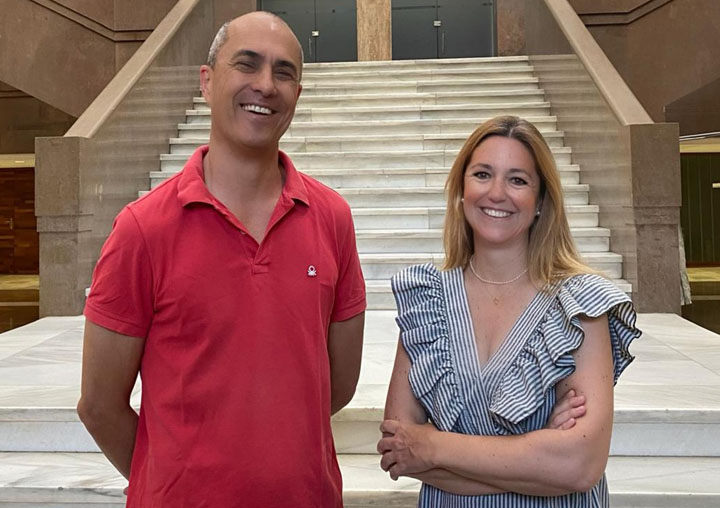Research shows that cells that interpret an increase in nutrients accelerate ageing and shorten lifespan
- Press Office
- June 7th, 2024

Cells receive signals of an increase in nutrients, which leads to malfunction and inflammation in organs such as the pancreas, liver or kidneys. This is a discovery from the CNIO team and the Universitat de València, published in Nature Aging. Its proposal is to target only the inflammation to relieve the symptoms and increase survival. The studies were carried out in animal models, but comparison of their molecular processes with septuagenarian blood samples shows that they can be extrapolated to human ageing.
As the aging population increases, it is fundamental to understand what happens over time in the organism on a molecular level. The protein complex mTOR is known to be involved in many processes and plays a key role in many functions of the organism, particularly in metabolism.
A new study in animal models shows that a moderate increase in the mTOR activity causes early ageing and shortens the lifespan of animals by up to 20%. Thus, animals whose cells 'think' they have too many nutrients, even on a balanced diet, age faster and live shorter.
Because of the key role of mTOR in metabolism, this research helps to understand why age-related diseases occur or worsen in people with a high body mass index, an indicator of obesity and inflammation. It also provides insight into why calorie restriction (a diet associated with longer lifespan in animals) may be beneficial for healthy ageing, since some genes are activated when nutrients that interact with mTOR are restricted.
According to the the study’s lead author, Alejo Efeyan, Head of the Metabolism and Cell Signalling Group at the Spanish National Cancer Research Center (CNIO), a new research tool has been created ‘to study the relationship between nutrient increase and the ageing of different organs.’
The study is published in Nature Aging. The first author is Ana Ortega-Molina, who currently heads her Laboratory of Metabolism in cancer and ageing at the Severo Ochoa Molecular Biology Centre (CBM), with collaborators Rafael de Cabo, from the National Institute on Aging (NIA) in Bethesda, USA, Consuelo Borrás and Daniel Monleón from the Universitat de València, and María Casanova-Acebes, Head of the Cancer Immunity Group at the Spanish National Cancer Research Center (CNIO).
Premature ageing in animals who ‘think’ they are eating more
The activity of the mTOR protein complex is regulated by the amount of nutrients available in the cell. The authors of the study developed a system to trick mTOR into regulating its activity at will in animal models.
There are many chemical signals within the cells that are carried by proteins, while cells communicate with each other through intercellular signals. The mTOR protein complex is a key player in the great cellular communication highway involved in energy use, the metabolism of the cell. Although it is still unclear how, mTOR is also known to have an influence on longevity.
To manipulate mTOR activity at will, the CNIO team focused on the protein responsible for sending the signal indicating the amount of available nutrients in the cell, rather than on mTOR itself. The research team genetically modified this protein so that it lies and sends a signal to mTOR that there are more nutrients in the cell than there actually are.
This activates the chemical signalling pathway of mTOR as if the animals were eating more, even if their diet was the same.
As the animals with this protein, which tricks mTOR, reach adulthood, their cells start to malfunction and symptoms of ageing appear: the skin becomes thinner and organs such as the pancreas, liver and kidneys are damaged. Immune system cells rush to repair them, but they are overwhelmed by the amount of damage, accumulate and, instead of repairing it, cause inflammation that further damages these organs.
The result of this vicious circle is that the lifespan of animals in which the mTOR works more than usual shortens 20 %, which in the human scale is around 16 years.
The study sought to break this circle by blocking the immunity response that causes the inflammation. Organ damage improved enough to gain the equivalent to some human years.
Thus, the study argues that acting on chronic inflammation is ‘a potential therapeutic measure to control health damage’, explains Ortega-Molina.
The results can be extrapolated to humans
Acting on the information received by the mTOR, simulating a nutrient excess, is similar to a natural ageing change. The CNIO group compared their model with colonies of naturally ageing mice, both from the group and from the National Institute on Aging (NIA).
For instance, lysosome activity, the organelles through which the cell disposes of and recycles its waste, is reduced in both naturally aged and genetically modified animals. ‘When there is an excess of nutrients, it makes sense that the cell shuts down the recycling activity of lysosomes, since this recycling operates especially when there are no nutrients,’ explains Efeyan.
This decrease in lysosome activity also occurs in human ageing, as stated by the UV group when comparing blood samples from septuagenarians and young individuals. The UV group has been studying the molecular processes associated with ageing for 20 years, with the aim of developing effective strategies to promote healthy ageing. Consuelo Borrás and Daniel Monleón believe that ‘this type collaborative research lays the foundations for a better understanding of the role of nutrition in healthy ageing and its connection to nutritional interventions, such as calorie restriction or intermittent fasting.’
A new tool
Efeyan believes that this new animal model provides ‘a fertile ground to ask further questions about how nutrient increase, or its signaling, facilitates processes in the different organs that allow us to understand their ageing in particular. Or, for instance, to study the relationship with neurodegenerative diseases, since there is some inflammation in the central nervous system. It is a tool that a lot more people will be able to use.’
Reference list:
Ana Ortega-Molina, Cristina Lebrero-Fernández, Alba Sanz, Miguel Calvo-Rubio, Nerea Deleyto-Seldas, Lucía de Prado-Rivas, Ana Belén Plata-Gómez, Elena Fernández-Florido, Patricia González-García, Yurena Vivas-García, Elena Sánchez García, Osvaldo Graña-Castro, Nathan L Price, Alejandra Aroca-Crevillén, Eduardo Caleiras, Daniel Monleón, Consuelo Borrás, María Casanova-Acebes, Rafael de Cabo and Alejo Efeyan. ‘A mild increase in nutrient signaling to mTORC1 in mice leads to parenchymal damage, myeloid inflammation and shortened lifespan.’ Nature Aging, 2024.
DOI: https://doi.org/10.1038/s43587-024-00635-x
Categories: Recerca, innovació i transferència , Facultat de Medicina i Odontologia , PDI















